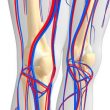Results of infrapopliteal territory revascularization in critical limb ischemia. Compared against the general population, patients suffering from critical lower limb ischemia (CLI) not only experience seriously limited quality of life, but also face a significant higher risk of death and amputation. Specifically, the optimal treatment for these patients remains uncertain. This uncertainty was sparked by<a href="https://solaci.org/en/2023/06/22/basil-2-revascularization-of-infra-popliteal-territory-in-patients-with-critical-lower-limb-ischemia/" title="Read more" >...</a>
Deep Vein Arterialization: Have We Conquered “Non-Revascularizable” Critical Limb Ischemia?
Deep vein Arterialization in patients with critical “non-revascularizable” limb ischemia. We are familiar with the poor quality of life and elevated mortality of patients with chronic limb-threatening ischemia (CLTI). In its last stages (nearly terminal), revascularization (either surgical or endovascular) has been shown to reduce amputation incidence. However, similarly to heart disease and other vascular scenarios,<a href="https://solaci.org/en/2023/04/03/deep-vein-arterialization-have-we-conquered-non-revascularizable-critical-limb-ischemia/" title="Read more" >...</a>
BEST-CLI: Revascularization of Critical Lower Limb Ischemia, a Pragmatic Study
Critical lower limb ischemia (CLLI) is associated with a major deterioration in quality of life and a significant increase in morbidity and mortality. Its estimated annual incidence is 220 to 3500 cases per million people, with an expected prevalence of 11% of patients with peripheral arterial disease. CLLI is the “terminal” stage of peripheral artery<a href="https://solaci.org/en/2022/11/22/best-cli-revascularization-of-critical-lower-limb-ischemia-a-pragmatic-study/" title="Read more" >...</a>
Drug-Coated Balloons in Critical Ischemia: The Paradigm of Randomized Evidence vs. Logbooks
This research, which included thousands of patients treated for chronic inferior limb ischemia with drug-coated balloons, did not show an association between said devices and the increased mortality observed in some randomized trials. The long-term evidence from plenty of real-world patients contradicts what has been shown in randomized trials, leaving an information gap. Endovascular revascularization<a href="https://solaci.org/en/2020/10/13/drug-coated-balloons-in-critical-ischemia-the-paradigm-of-randomized-evidence-vs-logbooks/" title="Read more" >...</a>
Common Femoral Artery Endarterectomy Plus Angioplasty in Critical Ischemia
This prospective study analyzed patients with critical lower limb ischemia (due to complex, multiple lesions in several places) who were treated uniformly with common femoral artery endarterectomy combined with angioplasty to improve inflow and/or outflow. This hybrid treatment, which must be carried out by a team, can be greatly beneficial for this high-risk patient group<a href="https://solaci.org/en/2020/05/26/common-femoral-artery-endarterectomy-plus-angioplasty-in-critical-ischemia/" title="Read more" >...</a>
Surprises in the Physiopathology of Critical Ischemia
Luminal thrombotic occlusions associated with non-significant atherosclerosis are commonly observed in patients with critical lower limb ischemia, which suggests the possibility of thromboembolic disease as a great contributor to ischemia. This was particularly verifiable in infrapopliteal vessels, thus showing a possible mechanism of progression from peripheral vascular disease to critical ischemia, as well as a<a href="https://solaci.org/en/2018/11/13/surprises-in-the-physiopathology-of-critical-ischemia/" title="Read more" >...</a>
What Is the Prognosis for Reinterventions in Critical Lower Limb Ischemia?
Infrapopliteal (below the knee, BTK) percutaneous transluminal angioplasty (PTA) has been acknowledged as a useful strategy in chronic critical limb ischemia (CLI), but artery calcification severity results in considerable restenosis. Repeat PTA and the management of trophic lesions help with wound healing. However, this conduct has not been extensively assessed. This study enrolled 152 patients (175 limbs)<a href="https://solaci.org/en/2018/03/14/what-is-the-prognosis-for-reinterventions-in-critical-lower-limb-ischemia/" title="Read more" >...</a>
The poor prognosis of critical limb ischemia related to sub treatment
Original title: Peripheral arterial disease and critical limb ischaemia: still poor outcomes and lack of guideline adherence. Reference: Reinecke H et al. Eur Heart J. 2015; Epub ahead of print. This work included 41882 patients retrospectively from health insurance in Germany admitted with diagnosis of peripheral vascular disease between 2009 and 2011 and followed until 2013. Patients<a href="https://solaci.org/en/2015/02/20/the-poor-prognosis-of-critical-limb-ischemia-related-to-sub-treatment/" title="Read more" >...</a>
Angioplasty versus surgery in patients with critical lower limb ischemia
Original title: Comparative effectiveness of endovascular andsurgical revascularization for patients with peripheralartery disease and critical limb ischemia: Systematicreview of revascularization in critical limb ischemia. Reference: W Schuyler Jones, et al. (Am Heart J 2014; 167:167:489-498.e7) Lower limbs critical ischemia is the most severe condition of PAD. The morbidity, mortality and costs related thereto are well documented; however, the<a href="https://solaci.org/en/2014/05/14/angioplasty-versus-surgery-in-patients-with-critical-lower-limb-ischemia/" title="Read more" >...</a>
Infrapatellar balloon angioplasty, the easiest option and with better results in critical ischemia with tissue loss
Original title: Longitudinal outcomes After Tibioperoneal Angioplasty Alone Compared to Tibial Stenting and Atherectomy for Critical Limb ischemia. Reference: Shaun Reynolds et al. Vascular and and Endovascular Surgery 2013 47(7):507-512 The Infrapatellar peripheral vascular disease has increased in recent years, relating to tissue loss and amputation. The therapeutic strategy is not clear, let alone the use of stents<a href="https://solaci.org/en/2013/11/21/infrapatellar-balloon-angioplasty-the-easiest-option-and-with-better-results-in-critical-ischemia-with-tissue-loss/" title="Read more" >...</a>









